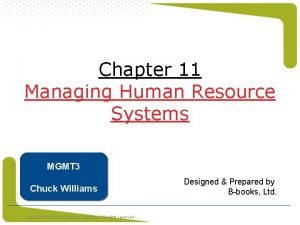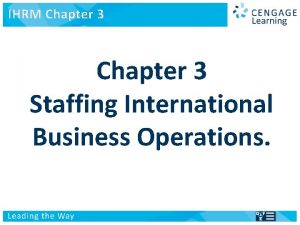Human Resource Management Training Human Resources CHAPTER 8












































- Slides: 44

Human Resource Management Training Human Resources CHAPTER 8 Robert L. Mathis | John H. Jackson | Sean R. Valentine 14 e © 2014 Cengage Learning. All rights reserved. May not be scanned, copied or duplicated, or posted to a publicly accessible Web site, in whole or in part.

Learning Objectives Define training and discuss why a strategic approach is important Identify three types of analyses used to determine training needs Specify how to design and evaluate an orientation program Explain different means of internal and external training delivery © 2014 Cengage Learning. All rights reserved. May not be scanned, copied or duplicated, or posted to a publicly accessible Web site, in whole or in part.

Learning Objectives Describe the importance of e-learning as part of current training efforts Provide an example for each of the four levels of training evaluation © 2014 Cengage Learning. All rights reserved. May not be scanned, copied or duplicated, or posted to a publicly accessible Web site, in whole or in part.

Nature of Training: Process whereby people acquire capabilities to perform jobs Benefits of training Provides employees with specific, identifiable knowledge and skills Greater Better ability to adapt and innovate self-management Performance improvement © 2014 Cengage Learning. All rights reserved. May not be scanned, copied or duplicated, or posted to a publicly accessible Web site, in whole or in part.

Difference between Training and Development Training Imparts specific, identifiable knowledge and skills for use in present jobs Development Broader in scope Focuses on gaining new capabilities useful for both present and especially future jobs © 2014 Cengage Learning. All rights reserved. May not be scanned, copied or duplicated, or posted to a publicly accessible Web site, in whole or in part.

Figure 8. 1 - Types of Training © 2014 Cengage Learning. All rights reserved. May not be scanned, copied or duplicated, or posted to a publicly accessible Web site, in whole or in part.

Legal Issues and Training Design and Delivery Criteria and practices used to select individuals Employees working overtime must be compensated Requiring signing of training contracts © 2014 Cengage Learning. All rights reserved. May not be scanned, copied or duplicated, or posted to a publicly accessible Web site, in whole or in part.

Benefits of Strategic Training Helps accomplish organizational goals Reduces tendency to depend on training lone to solve performance problems Helps assess whether training can address the most important performance issues © 2014 Cengage Learning. All rights reserved. May not be scanned, copied or duplicated, or posted to a publicly accessible Web site, in whole or in part.

Organizational Competitiveness and Training Knowledge management: The way an organization identifies and leverages knowledge to be competitive To be effective, training must be integrated with job performance and employee learning Sales training Improves Covers organizational competitiveness a wide variety of skills and strategy development © 2014 Cengage Learning. All rights reserved. May not be scanned, copied or duplicated, or posted to a publicly accessible Web site, in whole or in part.

Figure 8. 2 - Linking Strategies and Training © 2014 Cengage Learning. All rights reserved. May not be scanned, copied or duplicated, or posted to a publicly accessible Web site, in whole or in part.

Global Assignment Training Orientation and training that expatriates and their families receive before departure Affects the success of an overseas assignment Produces a positive effect on cross-cultural adjustment Crucial to global strategic success as businesses expand overseas © 2014 Cengage Learning. All rights reserved. May not be scanned, copied or duplicated, or posted to a publicly accessible Web site, in whole or in part.

Figure 8. 3 - Intercultural Competence Training Source: Developed by Andrea Graf, Ph. D, and Robert L. Mathis, Ph. D, SPHR. © 2014 Cengage Learning. All rights reserved. May not be scanned, copied or duplicated, or posted to a publicly accessible Web site, in whole or in part.

Training Plans Effective training efforts consider the following questions: Is there really a need for the training? Who needs to be trained? Who will do the training? What form will the training take? How will knowledge be transferred to the job? How will the training be evaluated? © 2014 Cengage Learning. All rights reserved. May not be scanned, copied or duplicated, or posted to a publicly accessible Web site, in whole or in part.

Orientation Planned introduction of new employees Achieves several key purposes Establishes Provides a favorable impression of organization and job information Enhances interpersonal acceptance by coworkers Accelerates socialization and integration of the new employee into the organization Ensures that employee performance and productivity begin more quickly © 2014 Cengage Learning. All rights reserved. May not be scanned, copied or duplicated, or posted to a publicly accessible Web site, in whole or in part.

Evaluating Orientation Evaluation Metrics Tenure turnover rate New hires failure factor Employee upgrade rate Development program participation © 2014 Cengage Learning. All rights reserved. May not be scanned, copied or duplicated, or posted to a publicly accessible Web site, in whole or in part.

Figure 8. 4 - Systematic Training Process © 2014 Cengage Learning. All rights reserved. May not be scanned, copied or duplicated, or posted to a publicly accessible Web site, in whole or in part.

Analysis of Training Needs Assessing Training Needs Organizationa l Analysis Job/Task Analysis Individual Analysis © 2014 Cengage Learning. All rights reserved. May not be scanned, copied or duplicated, or posted to a publicly accessible Web site, in whole or in part.

Figure 8. 5 - Sources of Information for Needs Assessment © 2014 Cengage Learning. All rights reserved. May not be scanned, copied or duplicated, or posted to a publicly accessible Web site, in whole or in part.

Establishing Training Objectives and Priorities Gap analysis: Indicates the distance between current and desired employee capabilities Types of Training Objectives Attitude Knowledge Skill © 2014 Cengage Learning. All rights reserved. May not be scanned, copied or duplicated, or posted to a publicly accessible Web site, in whole or in part.

Figure 8. 6 - Training Design Elements © 2014 Cengage Learning. All rights reserved. May not be scanned, copied or duplicated, or posted to a publicly accessible Web site, in whole or in part.

Learner Characteristics Ability to learn Motivation - A person’s desire to learn training content Self-efficacy: People’s belief that they can successfully learn the training program content Perceived Learning utility/value styles © 2014 Cengage Learning. All rights reserved. May not be scanned, copied or duplicated, or posted to a publicly accessible Web site, in whole or in part.

Principles of Adult Learning Adult learning: Ways in which adults learn differently than younger people Have need to know why they are learning something Have need to be self-directed Bring more work-related experiences into the process Adult Learning Employ a problem-solving approach to learning Are motivated by both extrinsic and intrinsic factors © 2014 Cengage Learning. All rights reserved. May not be scanned, copied or duplicated, or posted to a publicly accessible Web site, in whole or in part.

Instructional Strategies Learner Participation & Feedback Active Practice Performance of job-related tasks and duties by trainees during training Spaced Practice performed in several sessions spaced over a period of hours or days Massed Practice performed all at once © 2014 Cengage Learning. All rights reserved. May not be scanned, copied or duplicated, or posted to a publicly accessible Web site, in whole or in part.

Instructional Strategies Overlearning - Repeated practice even after a learner has mastered the performance Behavioral modeling: Copying someone else’s behavior Error-based examples - Sharing with learners what can go wrong when they do not use the training properly © 2014 Cengage Learning. All rights reserved. May not be scanned, copied or duplicated, or posted to a publicly accessible Web site, in whole or in part.

Instructional Strategies Reinforcement: Repeat Based on the idea that people: responses that give them some type of positive reward Avoid actions associated with negative consequences Immediate confirmation: People learn best if reinforcement and feedback are given as soon as possible after training © 2014 Cengage Learning. All rights reserved. May not be scanned, copied or duplicated, or posted to a publicly accessible Web site, in whole or in part.

From Training to the Job Transfer of training - Occurs when trainees: Actually Maintain To use on the job what they learned use of the learned material over time increase the transfer of training Offer trainees an overview of training content and process and how it links to the strategy of the organization Ensure that the training mirrors the job context © 2014 Cengage Learning. All rights reserved. May not be scanned, copied or duplicated, or posted to a publicly accessible Web site, in whole or in part.

From Training to the Job Support new trainees to use their new skills when they return to the job Supervisor Feedback support and involvement in the training from the supervisor Opportunity to use the training Accountability - Extent to which someone expects the learner to use the new skills on the job and holds them responsible for doing so © 2014 Cengage Learning. All rights reserved. May not be scanned, copied or duplicated, or posted to a publicly accessible Web site, in whole or in part.

Training Delivery Considerations Nature of Training Subject Matter Number of Trainees Individual Versus Team Self-paced Versus Guided Training Resources/Costs E-learning versus Traditional Learning © 2014 Cengage Learning. All rights reserved. May not be scanned, copied or duplicated, or posted to a publicly accessible Web site, in whole or in part.

Training Delivery Considerations Geographic Time locations allotted Completion timeline © 2014 Cengage Learning. All rights reserved. May not be scanned, copied or duplicated, or posted to a publicly accessible Web site, in whole or in part.

Figure 8. 7 - Training Delivery Options © 2014 Cengage Learning. All rights reserved. May not be scanned, copied or duplicated, or posted to a publicly accessible Web site, in whole or in part.

Internal Training Informal training: Occurs through interactions and feedback among employees On-the-job training (OJT): Based on a guided form of training known as job instruction training (JIT) Problems with OJT Poorly-qualified Disruption Bad or indifferent trainers of regular work or incorrect habits passed on © 2014 Cengage Learning. All rights reserved. May not be scanned, copied or duplicated, or posted to a publicly accessible Web site, in whole or in part.

Figure 8. 8 - Stages for On-the-Job Training © 2014 Cengage Learning. All rights reserved. May not be scanned, copied or duplicated, or posted to a publicly accessible Web site, in whole or in part.

Internal Training Cross-training: Training people to do more than one job Increases flexibility and development Challenges Is of cross-training not favored by employees Threatens unions with loss of job jurisdiction and broadening of jobs Requires May scheduling work differently cause temporary decrease in productivity © 2014 Cengage Learning. All rights reserved. May not be scanned, copied or duplicated, or posted to a publicly accessible Web site, in whole or in part.

External Training Advantages Less expensive to outsource training Insufficient Lack time to develop training of expertise Advantages Outsourcing of interacting with outsiders of training Government-supported Educational job training assistance programs © 2014 Cengage Learning. All rights reserved. May not be scanned, copied or duplicated, or posted to a publicly accessible Web site, in whole or in part.

Combination of Training Approaches Forms of Cooperative Training School-to. Work Transition Apprentice Training Internship © 2014 Cengage Learning. All rights reserved. May not be scanned, copied or duplicated, or posted to a publicly accessible Web site, in whole or in part.

Figure 8. 9 - Most Common Apprenticeship Occupations © 2014 Cengage Learning. All rights reserved. May not be scanned, copied or duplicated, or posted to a publicly accessible Web site, in whole or in part.

E-Learning: On-Line Training E-learning - Use of the Internet or an organizational intranet to conduct training on-line Methods of e-learning Distance training/learning Simulations: Reproduce parts of the real world so they can be experienced, manipulated, and learning can occur Games: Exercises that entertain and engage Mobile learning © 2014 Cengage Learning. All rights reserved. May not be scanned, copied or duplicated, or posted to a publicly accessible Web site, in whole or in part.

E-Learning: On-Line Training Blended learning: Combines methods, such as short, fast-paced, interactive computer based lessons and teleconferencing with traditional classroom instruction and simulation © 2014 Cengage Learning. All rights reserved. May not be scanned, copied or duplicated, or posted to a publicly accessible Web site, in whole or in part.

Figure 8. 10 - Advantages and Disadvantages of E-Learning © 2014 Cengage Learning. All rights reserved. May not be scanned, copied or duplicated, or posted to a publicly accessible Web site, in whole or in part.

Levels of Training Evaluation Reaction • Evaluated by conducting interviews or administering questionnaires Learning • Measuring how well trainees have learned facts, ideas, concepts, theories, and attitudes Behaviors • Measuring the effect of training on job performance through observing job performance Results • Measuring the effect of training on the achievement of organizational objectives © 2014 Cengage Learning. All rights reserved. May not be scanned, copied or duplicated, or posted to a publicly accessible Web site, in whole or in part.

Training Evaluation Metrics Cost-benefit analysis: A comparison of costs and benefits associated with organizational training efforts Return on Investment (ROI) Analysis Benchmarking © 2014 Cengage Learning. All rights reserved. May not be scanned, copied or duplicated, or posted to a publicly accessible Web site, in whole or in part.

Calculating Training Costs and Benefits 1. Determine overall training costs 2. Identify potential savings results 3. Compute potential savings 4. Conduct costs and savings benefits comparison © 2014 Cengage Learning. All rights reserved. May not be scanned, copied or duplicated, or posted to a publicly accessible Web site, in whole or in part.

Figure 8. 11 – Possible Costs and Benefits in Training © 2014 Cengage Learning. All rights reserved. May not be scanned, copied or duplicated, or posted to a publicly accessible Web site, in whole or in part.

Internal Evaluation of Training Evaluation Designs Post-Measure Pre/Post. Measure with Control Group © 2014 Cengage Learning. All rights reserved. May not be scanned, copied or duplicated, or posted to a publicly accessible Web site, in whole or in part.
 Methods of training in human resource management
Methods of training in human resource management Time management human resources
Time management human resources Retail org chart
Retail org chart Function of personnel management
Function of personnel management Human resource management chapter 2
Human resource management chapter 2 Chapter 9 human resource management
Chapter 9 human resource management Chapter 11 human resource management
Chapter 11 human resource management Human resource management chapter 1
Human resource management chapter 1 Human resource management lecture chapter 1
Human resource management lecture chapter 1 Human resources department structure
Human resources department structure Human resource management lecture chapter 1
Human resource management lecture chapter 1 Types of international assignment in ihrm
Types of international assignment in ihrm Human resource management chapter 4
Human resource management chapter 4 Functions of hrm
Functions of hrm Chapter 7 human resource management
Chapter 7 human resource management Chapter 7 human resource management
Chapter 7 human resource management Human resource management chapter 4
Human resource management chapter 4 Human side of project management
Human side of project management Human resource management chapter 5
Human resource management chapter 5 Human resource management chapter 5
Human resource management chapter 5 Chapter 11 human resource management
Chapter 11 human resource management Chapter 9 human resources management
Chapter 9 human resources management Training cycle steps
Training cycle steps Project human resource management pmbok ppt
Project human resource management pmbok ppt Resource management pmbok
Resource management pmbok Need of hrm
Need of hrm Restaurant human resources
Restaurant human resources Induction in human resource management
Induction in human resource management Hrms shanker group
Hrms shanker group Performance appraisal in human resource management
Performance appraisal in human resource management Current issues in human resource management
Current issues in human resource management Ba human resource management
Ba human resource management Acas employment tribunal
Acas employment tribunal Human resource management gaining a competitive advantage
Human resource management gaining a competitive advantage Downsizing
Downsizing Human resource management gaining a competitive advantage
Human resource management gaining a competitive advantage Human resource management question papers with answers
Human resource management question papers with answers Performance appraisal in human resource management
Performance appraisal in human resource management Gary dessler human resource management
Gary dessler human resource management Strategic human resource
Strategic human resource An investment perspective of human resource management
An investment perspective of human resource management Applied psychology in human resource management
Applied psychology in human resource management Introduction of hrm
Introduction of hrm Unit 3 human resource management
Unit 3 human resource management Separation in human resource management
Separation in human resource management

































































